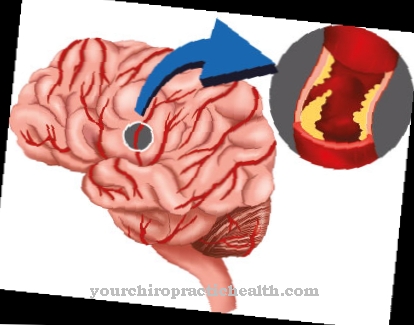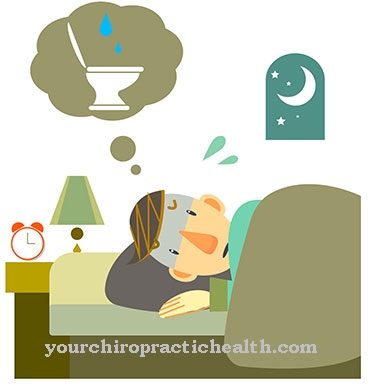The Pseudoparalysis indicates a paralysis that is not based on a disturbance of the nerve conductivity. There are several forms of pseudoparalysis. Your treatment depends on the cause.
What is pseudoparalysis?

© auremar - stock.adobe.com
The Pseudoparalysis is a collective term for paralysis that is not caused by changes in the conductivity of nerve cells. Therefore, by definition, it is an apparent paralysis. The prefix “pseudo” comes from the Greek and means something like deception. Thus, while pseudoparalysis is not true paralysis, it does appear with deceptively similar symptoms.
According to the definition, paralysis means complete paralysis of motor nerves in individual parts of the body. Since the transmission of nerve stimuli from the brain to the corresponding body sections is interrupted, individual muscles or muscle groups can no longer be stimulated there. The incomplete paralysis of the muscles, in contrast, is called paresis.
The pseudoparalyses include diseases that, among other things, resemble the appearance of progressive paralysis or other paralysis based on disorders of nerve impulse transmission. While progressive paralysis in syphilis is caused by nerve damage, similar symptoms are observed with alcohol abuse (alcoholic pseudoparalysis) or arteriosclerosis.
Furthermore, muscle paralysis can occur even after long periods of immobilization of the corresponding muscles or with muscle scars without impairing the transmission of stimuli. Pseudoparalyses are also known for vascular diseases and brain tumors. There is also the Parrot pseudoparalysis.
causes
The causes of pseudoparalysis are diverse. However, nerve damage is excluded in all of them. In this case it would be a real paralysis. Possible causes are muscle tears, muscle weakness, long periods of immobilization of the corresponding muscles, rheumatic diseases, but also diseases of the brain, alcohol abuse or arteriosclerosis.
In the case of muscle diseases, the signals from the brain reach the muscle via the motor nerves. However, due to muscle damage or weakness, they cannot be converted into muscle contractions. A typical example of this is the rotator cuff tear. This injury caused one or more of the tendons in the four shoulder muscles to tear. The arm hangs down because it is no longer possible to lift it from the side.
The shoulder tendons can also be calcified. The so-called calcar tendinitis of the shoulder tendons also causes paralysis of the arms. The so-called Parrot pseudoparalysis also results in a limp arm. The cause here is a detachment of the epiphyses, which occurs in the unborn child of a mother suffering from syphilis. Acute pseudoparalysis can also occur with calcified tendinitis in the hip joint.
The tendinitis calcarea of the hip, like that of the shoulder tendons, can be infectious, traumatic or neoplastic. The rotator cuff muscles are affected. With diseases of the brain, alcohol abuse or arteriosclerosis, insufficient signals are often sent via the motor nerve lines. This can also lead to apparent paralysis, along with other symptoms. Some pseudoparalyses can also be psychogenic.
Symptoms, ailments & signs
The symptoms of pseudoparalyses are similar to those of real paralyses and depend on the respective cause. Certain muscles or muscle groups become paralyzed. In the case of rotator cuff tears, Parrot pseudoparalysis and calcified shoulder paralysis in the shoulder muscles, which leads to the arms hanging down limply.
The causes for all three diseases are different, but do not affect nerve damage. The same applies to the tendinitis calcarea in the hip joint, which manifests itself in paralysis of the hip muscles and pain in the hip. As mentioned earlier, the opposite of progressive paralysis is pseudoparalysis with almost the same symptoms.
Progressive paralysis is caused by nerve damage in the context of syphilis. It leads to complete physical and mental degradation. The predominant symptoms are progressive dementia or the development of psychosis. In addition, there may be symptoms of paralysis.
Diagnosis & course of disease
Paralyses and pseudoparalyses are symptoms of various diseases that must be diagnosed. A comprehensive medical history is always required. Imaging procedures and laboratory tests are then used to specify the disease.
Complications
The complications and the further course of a pseudoparalysis depend very much on the underlying disease. For this reason, a general prediction of the complications is usually not possible. However, those affected suffer from paralysis in various parts of the body due to the disease. This can lead to movement restrictions and other restrictions in the patient's everyday life.
Most of those affected are then dependent on the help of other people in their everyday lives. It is not uncommon for pain or tension to occur in the hip. This pain often spreads to the back, so that those affected also suffer from pain there. If the pseudoparalysis is not treated, the physical and motor functions are reduced, so that there is also mental retardation.
In most cases, the symptoms of dementia or psychosis appear. The pseudoparalysis also has a very negative effect on other people, so that it can lead to social complaints and depression. The treatment of pseudoparalysis is done with the help of drugs and various therapies. Complications rarely become noticeable. However, a cure for the pseudoparalysis cannot be guaranteed.
When should you go to the doctor?
In the event of pseudoparalysis, a doctor should always be consulted. This disease does not heal itself and in most cases the symptoms worsen. The person concerned must therefore always contact a doctor if the symptoms of pseudoparalysis occur. The doctor should be consulted if paralysis occurs in various muscles in the body. The paralysis can occur sporadically and does not have to be permanent.
However, sporadic paralysis that occurs for no particular reason always indicates pseudoparalysis. The earlier the doctor is consulted, the higher the probability of a positive course of the disease. In some cases, psychological complaints or mental deterioration can also indicate the pseudoparalysis and should therefore be examined by a doctor. Friends or relatives can also recognize the symptoms of the disease and persuade the person concerned to see a doctor. The life expectancy of the patient may also be reduced by the pseudoparalysis.
Treatment & Therapy
The therapy of the pseudoparalysis depends of course on the respective cause. A rotator cuff tear is initially treated conservatively. If the pain is very severe, an operation is necessary in which parts of the chest muscle are transferred to the shoulder. Conservative treatment includes the administration of non-steroidal anti-inflammatory drugs and analgesics.
Glucocorticoids are injected under the roof of the shoulder. Physiotherapy with muscle building, manual therapies and various physical therapies also take place. A tendinosis calcarea of the shoulder or hip joint is initially treated conservatively until the calcium deposits dissolve.
If this is not successful, various surgical therapies such as shock wave therapy, calcium removal or arthroscopy are available. For all further pseudoparalyses, the underlying disease must be treated. Your prognosis depends on the success of the treatment for the underlying disease.
You can find your medication here
➔ Medicines against muscle paralysisprevention
A general recommendation for the prevention of pseudoparalyses cannot be given because the causes of the paralysis are very different. Often it is just a symptom of an underlying medical condition. The risk of pseudoparalysis can of course be significantly reduced by preventing diseases such as diabetes or arteriosclerosis. Therefore, a healthy lifestyle with a balanced diet, plenty of exercise and abstinence from alcohol and smoking is generally recommended.
Aftercare
Follow-up treatment is required if the pseudoparalysis is caused by a tear in the rotator cuff in the shoulder and a surgical procedure is therefore required. Follow-up care is then extremely important. Follow-up treatment begins on the first day after the operation. The patient receives effective pain therapy that is individually tailored to him.
The primary goal is to avoid painful complaints. In addition, special physiotherapy exercises are carried out, which are also individually adapted to the patient. For this purpose, the doctor first puts together a therapy plan. In physiotherapeutic follow-up treatment, it is important, on the one hand, to keep the seam largely still, and, on the other hand, to avoid muscle wasting.
In the first ten days after the operation, the patient should take care of his arm. He is also given an abduction pillow at an angle of 45 degrees for a period of four to six weeks. At the same time, mobilization exercises are started under the guidance of a physiotherapist.
Through the exercises it is possible to improve tendon sliding and to achieve greater tear resistance. In the further course, active exercises such as sliding exercises or pendulum exercises follow. After about six weeks, device-supported physiotherapy begins. Overall, the rehabilitation phase takes about three to six months. Around 50 percent of all positive treatment successes are due to consistent follow-up treatment.
You can do that yourself
If the doctor has made the diagnosis of pseudoparalysis, he will do everything necessary to find out the cause of the paralysis. Because when the disease underlying the pseudoparalysis is cured, the affected part of the body is usually mobile again, provided the patient follows the doctor's therapy instructions.
This adherence to therapy - also known as “compliance” - is extremely important, as otherwise the healing of the pseudoparalysis cannot be guaranteed. Depending on the underlying disease, several years of treatment with various therapeutic approaches as well as medication and / or surgery may be necessary.
For many patients, pseudoparalysis is very stressful. It leads to a reduction in the quality of life and also often means that the patient is dependent on others because, for example, he can no longer dress himself or cope with his everyday life. This also stresses the relatives of the patient and can lead to social problems. This in turn leads to mood disorders and even depression in the patient. An accompanying psychotherapy is advisable here.
Furthermore, the pseudoparalysis patient benefits from a healthy lifestyle in order to better heal the underlying disease and prevent a new disease. Sufficient sleep and exercise in the fresh air are just as important here as a balanced diet with fresh, healthy foods and lots of fruit and vegetables.

.jpg)



.jpg)





















